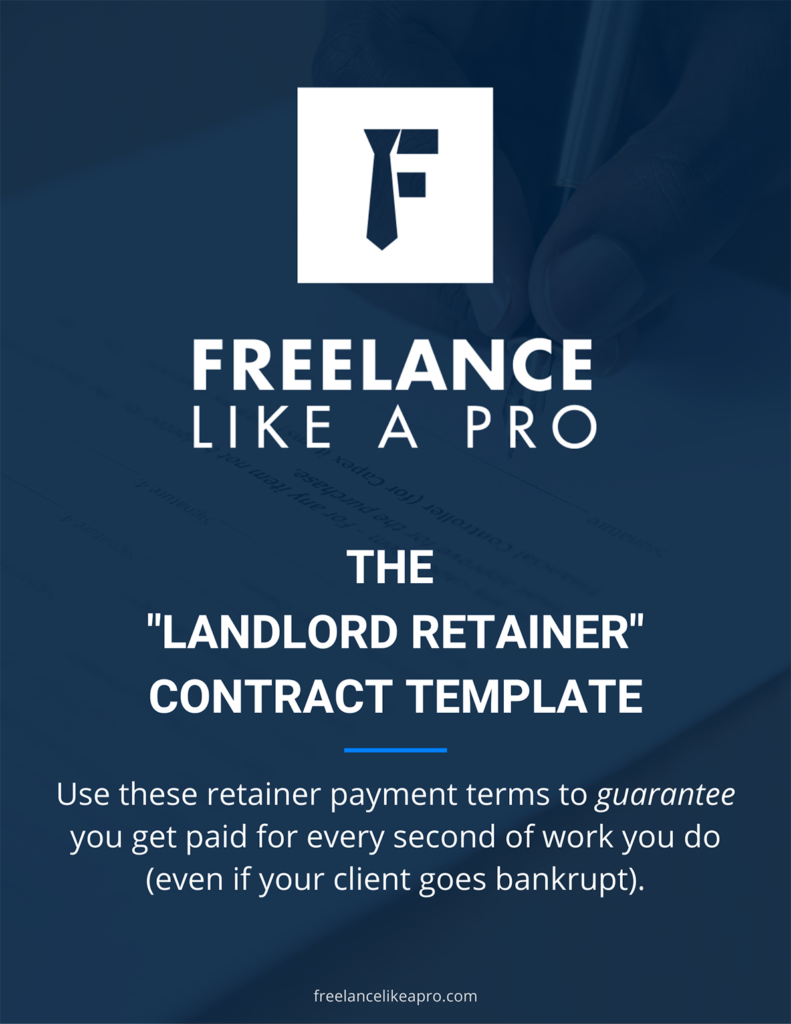It’s time for another hard-hitting freelancer Q&A! This time, I have a few questions about how to structure and then sign clients to retainer deals. And I’m going to walk through how you decide what services to offer, how to get your client to hire you for those services, and then how you prevent the client from taking up too much of your time.
(Note: this is different from my Landlord Retainer — which focuses on your payment terms, and comes up again towards the end of this email.)
And in case you missed it, last time I answered a question about how to handle a client that won’t pay on time.
How To Sign Clients To High-Paying Retainers
Today’s first question comes from a freelancer named Claire. She asked me…
“I would LOVE to know more about how you land retainer clients. I am making good money from my freelance side business (still working full-time as well) but all of my clients are on a per-project budget. I get regular work from these people – but I direct bill after each article. I would LOVE to turn this into more sustainable retainer income, but I feel like I don’t know how to make the jump from project-to-project billing to value-based retainers.”
Now Claire is in a lucky spot. Since she already has repeat clients.
And in that case, all you have to do is email your repeat clients with a message like this…
I’m looking to move a few of my best clients (like you) from project-based work to a monthly retainer, since I think it will be a win-win for both of us.
First, you would benefit because I will be able to offer you a better rate per article on a retainer. Plus you’d also save time when I work even more closely and seamlessly with your team on a monthly basis.
On my end, switching to a monthly retainer means that I will add more stability to my income. Plus I also won’t have to spend as much time chasing down new business every month. And with the time I save, I’ll be able to focus more on revenue-generating projects that ultimately grow my business.
In other words, having consistent monthly retainers saves me from wasting time chasing down new work and directly helps me grow my business. So if you can help me save time by switching to a retainer, I can pass those “savings” along to you in the form of a lower rate per article. Which makes it a win-win.

At the same time, if you do not have repeat clients right now, you can still use the same positioning that I shared above with brand-new clients to show them why they should hire you on retainer.
So that’s how I would go about closing more retainer deals.
Now let me answer a second question about…
How To Structure Your Retainers To Make More Money & Avoid Scope Creep
The next question is from an anonymous reader. And they wrote…
When I’ve discussed possible retainers in the past, the clients need different deliverables from month to month. So one month they’ll want a landing page, then an email sequence, then a video script. And when the scope keeps changing like that, the only way I can think to charge is based on hours. Any advice on the best way to approach this?
Now this is a GREAT question. Because it shows that this Pro-Lancer understands that when you’re only paid for your time, scope-creep can become a big problem.
So here are a few ways I’ve been able to make retainers my bread-and-butter — without driving myself crazy and fighting against scope-creep all the time.
Set An Upper Limit On Your Time — But Not A Lower Limit
First, in my contract, I spell out that the client has access to my time up to a fixed number of hours. But beyond that, we both mutually have to agree to any overages:
Here’s exactly what my retainer agreement says. (Remember though, I’m not a lawyer and don’t play one online — so get your own legal advice.)
Client will have monthly access to Contractor for any projects to help deliver the desired return on investment, not to exceed XX hours per month unless agreed in advance.

This takes care of a few things:
First, it clearly defines that there is no MINIMUM amount of work I have to deliver in order to get paid.
Which means even if the client doesn’t use my services for a full month, I still get paid for that month. (Since I have to set aside time in my calendar to be available for them and turn down other work to hold that space — whether they use it or not.)
Plus it also says that we mutually need to agree to any overages. So I have the power if necessary to turn down a project if it’s going to exceed the bandwidth I have in a given month.
But then in my conversations with my clients, I tell them that as long as they’re cool about it, I’ll always get them what they need. (In other words, I’ll always “agree in advance” to go over the retainer — provided the client doesn’t take advantage of it.)
And if a client is regularly going over the scope of their retainer, I have a mechanism in the contract to raise my rates based on the larger-than-expected workload. Or to enforce boundaries with the client about how much I can handle for them in a given week.
How to Manage the Day-to-Day of Your Retainers
Now once the contract is in place, I also do a few things during the day-to-day of the retainer to manage the workload and help prevent scope creep.
- I have a call with my clients once every week (or sometimes once every two weeks). And on the call, I will commit to a certain set of deliverables between then and the next call.
- After that, it’s my responsibility to deliver everything I promise. And if I underestimate the time it takes, in most cases I’ll eat that time and take responsibility for the fact I did a bad job estimating how long the projects would take.
- But if the client asks for new projects or a change in scope between calls, I can tell them that they have to remove one or more of the projects I originally agreed to deliver if they want to fit in a new project.
So basically, it’s an ongoing balance where I take responsibility for estimating how long things will take, telling the client what I can deliver, and then delivering that work no matter what.
Which also means I have to set boundaries and let them know if they’re asking for more in a given week than I can deliver.
And if that happens over and over again, it means we need to expand the retainer.

Never Miss A Payment Again With My “Landlord Retainer”
When it comes to actually getting paid on retainer, I’ve already written in detail about the two biggest mistakes freelancers make with their billing terms. And how you can fix them by using my Landlord Retainer to collect your last month’s payment upfront (among other things).
On top of that, I also created a copy-and-paste Landlord Retainer contract template. It gives you the exact payment terms I use in my retainer contract, which has generated over a quarter million dollars in the last two-plus years.
I only share my Landlord Retainer contract template with people on the Freelance Like A Pro email list, though.
So to grab your copy of the Landlord Retainer contract template, enter your first name and best email below to join the Freelance Like A Pro email list.
When you do, I’ll send you your own copy-and-paste-ready contract template — including all seven paragraphs of my Landlord Retainer billing terms — along with other members-only emails and resources to help you run a more profitable and stress-free freelance business.
Grab the copy-and-paste-ready Landlord Retainer contract template now
Enter your first name and best real email (no aliases)
 100% Secure. No Spam.
100% Secure. No Spam.


